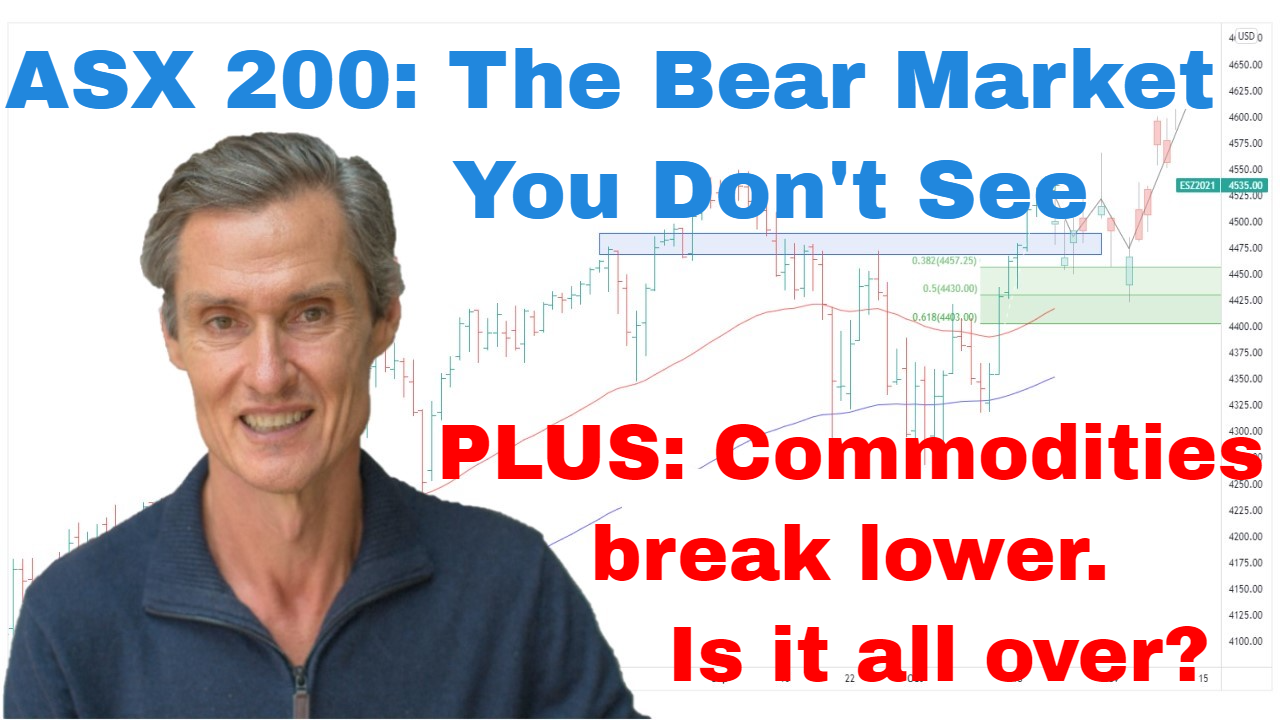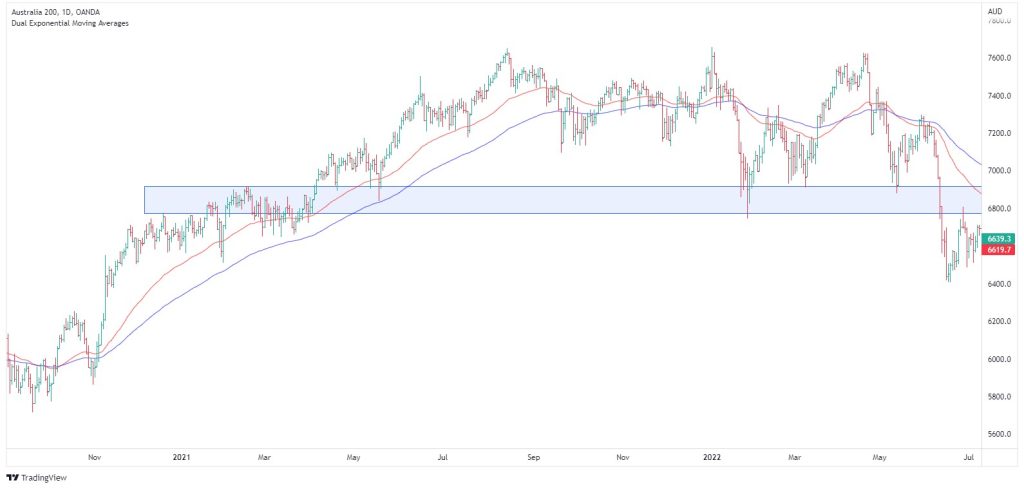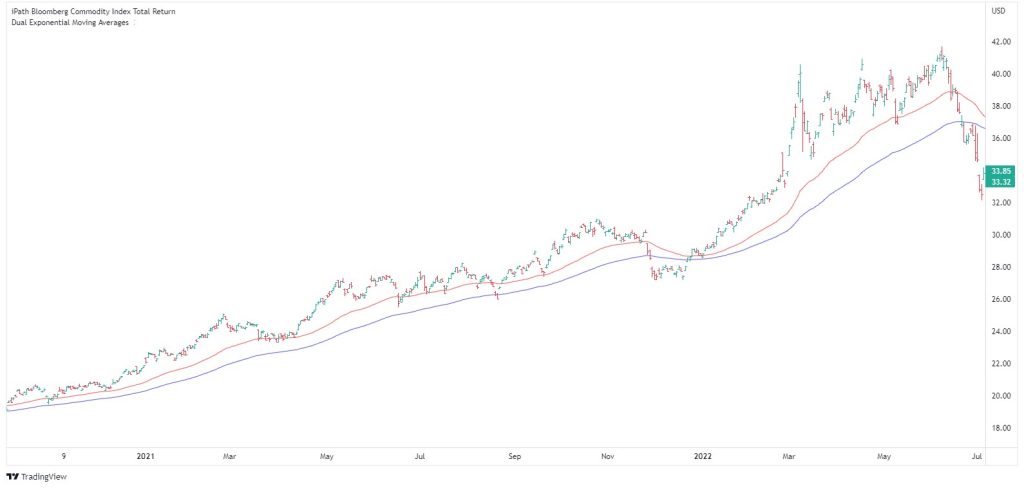ASX 200 Pinned By MAJOR Resistance | Episode 49

By Jason McIntosh | Published 8 July 2022
Trade the Trend is a weekly video focusing on where the stock market is going. It’s for investors and traders looking for insights to the market’s next move. Jason uses technical analysis of stocks and trend following techniques to help you piece together the world’s biggest puzzle.
Where is the Stock Market Going?
00:00 Intro
00:27 Why the ASX200 is vulnerable (and what you should do)
03:00 Be alert for this price action
03:57 Why the ASX is doing much worse than it appears
08:10 A rapid sell-off in commodities (what comes next)
Transcript (abridged)
Please note: Charts available from video
It’s been a relatively quiet week for the ASX 200. I think the key feature on this chart is this big resistance band which between 6,750 and 6,900. I think that the ASX 200 remains vulnerable whilst it’s below this resistance band.
Here’s the chart:

The moving averages are also worth noting. I’m using the 50-day and the 100-day moving averages, and they’re both continuing to decline. So, technically, the ASX 200 is in a weak position.
I want to put on some Fibonacci retracement levels (see video). And when we do that, you’ll see that the latest rally didn’t even get back to the 50% retracement. I think that is concerning. It’s concerning when the market bounces and doesn’t get to the 50% retracement, and then starts to retreat. We’ve got a situation where there’s heavy overhead resistance and a Fibonacci retracement zone capping the market. I think that until the ASX 200 can break above resistance, that we need to remain highly defensive.
It looks like the ASX 200’s price action is starting to coil up. One of the possibilities is that it forms a triangle trading range. It’s possible that such a range could form over the next week or two and then break to the downside. That’s one of the risks. The risk is that if this sideways motion continues, that it is just a consolidation before another leg lower. So, it’s one of the reasons why I think we need to remain defensive.
On the surface, it looks like the ASX 200 isn’t doing that badly when you compare it to some global markets that are down somewhere between 20% and 30%. The ASX 200 it only down about 16% from its high. So, it’s doing relatively well, and it’s not officially in bear market territory.
But a lot of the weakness I think within the ASX is being masked by relative strength in a few big cap stocks, stocks like BHP and CBA. And that’s because the ASX 200, of course, is a capitalization index, which means that it gives a bigger weighting to the larger stocks.
I want to show you another index which takes that capitalization factor out. This is the ASX 200 Equal Weight Index (see video). What it does is weigh each stock equally. So, the biggest stock and the smaller stock in the ASX 200 have the same impact on the index. And we measure the decline from the high to the low, we get a decline of about 24%. From this perspective, the ASX is very much in a bear market.
We’ve been seeing a modest rebound in the equal weighted index over the last couple of weeks from oversold levels. Prices were stretch below the moving averages. It’s a bit like an elastic band when the prices get so stretched from the moving averages, it does have that tendency to recoil back. But at this stage, I think we should assume that this is a bear market bounce.
I think an added risk for the Australian market is this week’s breakdown in commodities as a resource sector really has been a key support for the local market. And it’s one of the reasons why the ASX 200 has been holding up so well because of stocks like BHP and RIO. They have been declining, but they’re not falling away like some of the tech stocks in the U.S. So, that’s been bolstering the local market. This commodities breakdown we’re now seeing is going to weigh on the market.
All right. So, let’s go over and have a look at what commodities have been doing.
Here’s the Bloomberg commodity index:

Over the last few days, commodities have gone from a moderate pullback to quite a significant correction. This is a 20% decline. It’s also one of the quicker selloffs that we have seen in this commodity index.
Another significant development is that the sell-off is widespread. It’s across most commodity classes… from the industrial metals to precious metals, grains, like wheat and barley, softs like corn, and even energy. Energy has been one of the strongest components of this index. And energy still remains relatively strong, but even this has been pulling back.
There’s been a lot of technical damage done, particularly in the last four days. And I think it’s going to take time for this to form a base and start to potentially start turning higher again. We’ve also got the breakdown below the 50 and 100-day moving averages. The moving averages are now rolling over and look like they could cross in the next week or so.
I still think there’s a good medium to longer-term story in commodities. When we look at a weekly chart, commodities are coming off low levels. But the rally over the last two years has been very strong. It’s only normal for the market to pull back, and these pullbacks take time. A consolidation in commodities could go on for the rest of the year, and we could see lower levels.
As I said, I think the longer-term story is good. But given the extent of this breakdown, I think commodities could become a drag on the ASX, at least over the shorter term.
Let’s have a quick look through some of the commodities. Starting with iron ore, which is going to impact BHP and Rio and Fortescue. We had that classic rebound after the 2021 sell-off. But the recover stalled at the Fibonacci retracements and prices are rolling over again. The moving averages are also trending lower, and momentum has shifted to the downside. I think that will put pressure on BHP, Rio, and Fortescue over the next few months.
Gold is also struggling. The last time I spoke about gold was when it broke lower in May. I said it was now time to stand aside. The moving averages has since turned lower and the price is breaking lower again. I believe the next stop for gold is support at around $1,680. I think it’s quite likely gold is going to test this this level in the weeks ahead.
Looking at copper. It’s another one that is below the 50 and 100-day moving averages. It’s so stretched to the downside that it could have a rebound. But there’s been a lot of technical damage done. It’s going to take time for it to base and to potentially turn higher again. That’s the general pattern across all these commodity markets.
A key feature for all the commodity markets has been the surging U.S. dollar. We’ve also got a general risk-off environment, negative sentiment, and lots of talk of recessions. I think there’s going to be some great opportunities when the dust settles, particularly in this commodity sector, and copper is one of the ones I’m really watching with a lot of interest.
But for now, I don’t think it’s the time for taking a big risk. I think we need to keep our powder dry… we need to wait for the price action to suggest when it’s time to get back in. A big part of these bear market periods is to protect your capital. We want to make money, of course, but we want to make it when the time is right. When conditions aren’t suitable, we need to protect capital. So, we’re ready when the conditions do turn, which they invariably will.
Please see video for more detailed analysis and charts
Looking for the best ASX stocks to buy now?
Motion Trader‘s algorithms scan more than 2,000 ASX stocks daily in search of medium term investment trends. We then tell our members precisely when to buy shares. And most importantly, we tell them when to sell.
Try a no obligation FREE 14-day trial of Motion Trader, and see what an algorithmic trading approach could do for you.

